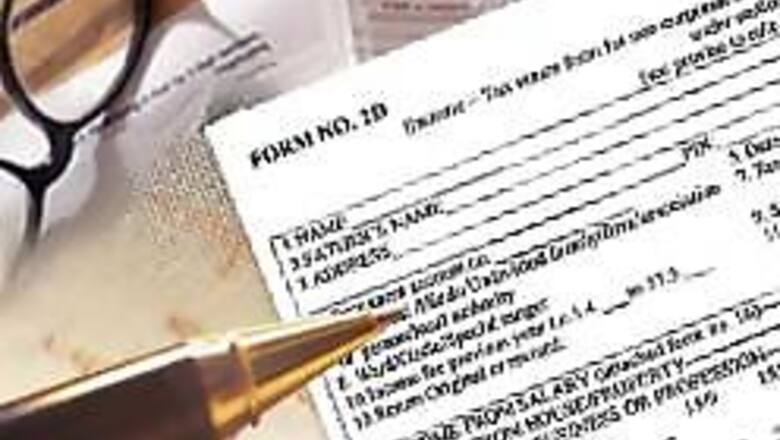
views
New Delhi: As the financial year 2005-06 is coming to close, the individual tax payers now seem to start worrying about their income-tax matters and the search continues for tax saving schemes. Subhash Lakhotia helps.
Many of the Salaried employees would not be able to receive in hand their monthly salary for the balance period of the financial year 2005-06 specially because of the fact that such employees would now be under financial constrain as a result of investments to be made by them for achieving tax saving. Generally at the beginning of the year the Salaried employees give an undertaking to their employer that they would be making particular investments t o cut down their tax payments. In the first ten months of the financial year such employees do not made the required investments.
And now is the time when they should make the investment or suffer the burden of higher tax payment. It is in such a situation that for most salaried employees the next few days before the close of the accounting year would look like a war like situation and this war is for money which is either to be invested or is to be paid by way of Income-tax. As soon as the targets for investments to achieve tax deduction have been achieved the tax payer starts thinking that he has reached the moon.
Well, for all tax payers mainly the Individuals as also the Hindu Undivided Families the investment plans now should start so that Income-tax is saved to the maximum permissible limit by taking full advantage of tax deduction and tax rebates.
As the financial year 2005-06 is coming to close, the individual tax payers now seem to start worrying about their income-tax matters and the search continues for tax saving schemes. Making investment in certain sectors would be the best available tax planning tip right now for most tax payers specially when the investment results into tax saving by way of tax rebate.
Step 1:
To invest immediately the sum of Rs.10,000 by way of contribution to a pension fund so as to receive a deduction @ 100 per cent of the investment. It may be recalled that deduction is available to an individual tax payer as per section 80CCC @ 100 per cent of the payment made to any pension fund to effect or keep in force a contract for any annuity plan of Life Insurance Corporation of India or any other insurer for receiving pension from the fund. The maximum amount eligible for deduction is Rs. 10,000 p.a. Please do remember that on and from the Assessment Year 2006-07 the maximum deduction available under section 80C is Rs 1 lakh, this is inclusive of the deduction under section 80CCC.
PAGE_BREAK
Step 2:
Similarly, if the tax payer has not yet made payment of the Medical Insurance premium then it is time now to take out such medical insurance policy and make payment upto Rs. 10, 000 p.a. which is allowed as a deduction under section 80 D from your income of the year. In case such premia is in respect of persons who are senior citizens then the maximum amount which would be eligible for tax deduction would be Rs. 15, 000 p.a.
Step 3:
Another important deduction which can be enjoyed by a tax payer would be in respect of Donations to certain recognised funds and charitable trusts and institutions. Always do remember that the benefits for deduction in respect of donations would be available only if such donation is given to a recognised trust or institution which has obtained a certificate under section 80 G of the Income-tax Act, 1961. The maximum amount eligible for deduction under section 80 G is 10% of the total income while the rate of deduction is 50%. However, certain donations like donation to Prime Minister’s National Relief Fund are eligible to deduction @ 100% and the monetary ceiling also does not apply.
Now is the time to take care of Income-tax deduction for the financial year 2005-06. Certain investments if made can result into tax saving by way of tax deduction.
Step 4:
Individuals and HUFs are entitled to claim tax deduction under Section 80C of the Income-Tax Act, 1961 by making investments in certain assets upto a maximum of Rs.1,00,000 in the financial year 2005-06, relevant to the assessment year 2006-2007.This deduction is available irrespective of the taxable income of the tax payer.
The tax payers should remember that from the financial Year 2005-06 the concept of granting tax rebate for investments etc made under section 88 of the Income tax Act 1961 has been done away with. Now as a result of insertion of new section 80C to the Income-tax Act 1961 a deduction would be permissible to all individuals and Hindu undivided families in respect of investment made by them or expenses incurred by them as mentioned in the said section 80C of the Income-tax Act, 1961.
The maximum amount that can be invested/spent for claiming the tax deduction is Rs. 1,00,000. The best part of the new provision is that the tax payer can invest the entire sum of Rs. 1 lakh in the ratio in which he desires. Thus, if an individual say is interested to make payment of Rs. 1 lakh only for Life Insurance Premium then he can do so and enjoy full deduction to the extent of Rs. 1 lakh. Similarly if a person wishes no other investment to avail tax deduction then he can do and avail deduction on housing loan repayment to the full extent of Rs. 1 lakh. Similarly, one another person say is interested to spend the entire Rs. 1 lakh on the education of his children, he can also do so and enjoy full tax benefit of deduction under the new section 80C of the Income tax Act, 1961.
PAGE_BREAK
The following is the list of items which are eligible for tax deduction of Rs 1,00,000 as per section 80C:
1. Payment for Life Insurance Premium
2. Payment for Deferred Annuity Plan
3. Deferred Annuity payable by Govt.
4. Contribution to Public Provident Fund
5. Contribution to Provident fund set up by Central Government
6. Contribution to Recognised Provident Fund
7. Contribution to recognised superannuation fund
8. Subscription to any security or deposit notified by Govt.
9. Subscription to Saving Certificates
10. Subscription for Unit Linked Insurance Plan 1971
11. Contribution for Unit Linked Insurance plan of LIC
12. Payment for Annuity plan of LIC or any other Insurer
13. Subscription to units of notified Mutual Funds
14. Contribution to Notified pension fund of Mutual Fund
15. Pension fund set up by National Housing Bank
16. Subscription to Deposit Scheme of Public Sector Company engaged in providing long term finance for house.
17. Tuition fees of two children in India
18. Payment of installment for self-financing of a Residential Property for repayment of loan.
19. Subscription to equity shares or debentures as approved for Infrastructure.
20. Subscription to any units of Mutual Fund as approved by the Central Board of Direct Taxes.
Note: Total amount allowed as deduction is limited to Rs. 1 lakh inclusive of deduction as per sections 80C, 80CCC, 80CCD and new section 80CCE.
Suggested investment plan options for tax deduction for young taxpayers
Life Insurance Premium - Rs.10,000
Provident Fund/Public Provident Fund - Rs.30,000
Amount spent on education of
two children - Rs.20,000
Repayment of Housing Loan - Rs.10,000
Equity Linked Savings scheme - Rs.30,000
Total - Rs 1,00,000
Suggested investment plan of investment options for tax deduction for tax payers in the age bracket of 50 years and above
Life Insurance Premium - Rs.10,000
Provident Fund - Rs.30,000
National Saving Certificate - Rs. 20,000
Housing loan repayment - Rs 10,000
Equity linked saving scheme - Rs 30,000
Total Rs - 1,00,000
Suggested investment plan of investment options for retired persons and senior citizens for tax deduction
National Savings Certificate - Rs.50,000
Equity Linked Savings Scheme - Rs.50,000
Total - Rs 1,00,000
Those investors who need the early release of their funds invested for tax deduction purposes should choose National Savings Certificates as opposed to Public Provident Fund because the latter is a 15-year savings plan while NSCs have a much lower term. On the other hand, those investors who wish to multiply their investments should opt only for Equity Linked Savings Schemes with a three-year lock-in-period, thus availing of long-term capital gains tax benefit subject to the Cost Inflation Index.
Tax payers who fall in the highest income bracket should choose PPF rather than NSCs as an investment. The reason being that interest accrued on NSC every year, is liable to annual taxes, despite the interest not being physically available to the taxpayer. On the other hand, interest earned on PPF is totally tax free. The interest earned on NSC is eligible to tax deduction but such interest income as such does not enjoy any tax benefit.
Hence, those tax payers who can afford to block their funds upto 15 years should now go in for investment of Rs.70,000 in PPF account each year in the name of every adult family member so as to reap the benefit of not merely tax rebate but even tax free interest income.
PAGE_BREAK
Although there is no upper limit (within the available Rs. 1,00,000) for investments in premiums paid for a Life Insurance policy still it is not financially sound to spend the entire Rs.1,00,000 on insurance premiums. This is simply because the value of the cash received after a long period of time (on maturity of the policy) will have depreciated considerably, whereas investments in other assets, such as property etc., will appreciate in value in future.
From the point of view of tax planning, taxpayers should pay for premiums on his own policy. The reason is, that in the case of a wife’s life insurance policy, on maturity, the sum will be treated as belonging to the husband so consequently income therefrom would be an income of the husband and will become liable to tax in his account. Instead, amounts paid towards insurance premiums for dependants should be gifted to them first and the payments made out of those designated gift amounts. Thereby, the amount accrued on the policy will be treated as belonging to individual children only and not clubbed with that of the premium payer (father or mother, as the case may be). It is also possible to pay insurance premiums on dependant children and then gift away the premium amount. There is no gift tax to be paid now.
In the case of joint holders of National Savings Certificates, deduction claims will apply to the person who has contributed to its purchase. Similarly, no matter in whose name a property may be in or an asset may belong to, for taxation purposes, it is the person who has contributed money towards its purchase who will be eligible to tax claims. Do not forget to claim deduction in respect of Interest payment for self occupied residential house property upto Rs. 1,50,000. This deduction would be available even if the payment of interest has not actually been made.
The young tax payers while claiming tax deduction under section 80C should take full advantage of the tax deduction which is permissible to them without any upper limit within the overall limit of Rs. 1,00,000 on account of Tuition fees to any university, college, school or other educational institutions situated within India for full time education of the children. It may be noted that this benefit is not available on the education expenses of grand children.
Now is the time for all the tax payers to get ready for making their funds available for investments to achieve tax deductions and thereby enjoy tax saving in respect of tax payable for the financial year 2005-06 relevant to the Assessment year 2006-07.
The author is tax and investment consultant for the last over 35 years.




















Comments
0 comment